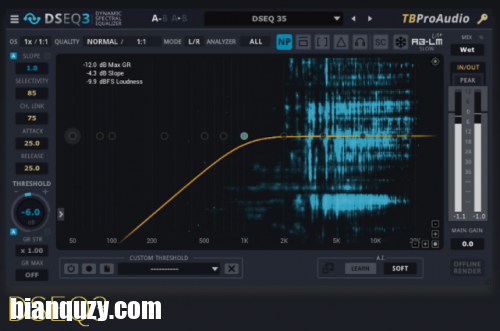
摩卡| 2022年12月26日| 8 MB
Knocktonal是一个基于音符的共振增强器,允许用户增强(或削减)共振以及相应的谐波泛音。简单地说,Knocktonal允许鼓调通过eq,而不需要重新投球样本。这是非常有用的,因为破坏性的重调或音调转换通常会以消极的方式影响声音的调性。这可能包括不必要的瞬态、纹理、攻击和声音的衰减。Knocktonal允许这些共振增强/削减被静态控制,或动态控制自动化或MIDI输入,后者可以创建一些令人难以置信的独特的旋律音调增强。Knocktonal也可以用来把简单的鼓的声音像短踢,变成808的长尾巴通过缩小共振Q控制(#10插件概述)。
减去的情商
Knocktonal的减法EQ部分旨在去除任何不必要的共振频率,预先存在于您正在使用的音频中。在增强任何新的共鸣之前,这对于实现“空白石板”是有用的。与插件的加法谐振部分一样,可以通过几种方式控制减法EQ。首先,静态地,简单地设置并保存它。这对于在整个表演中都相同的一次击鼓声音很有用。减法EQ还可以动态控制具有移动共振的声音,例如旋律表演。这可以通过两种方式实现。首先,通过使用自动化,其次,通过发送一个MIDI信号到插件的MIDI通道2。
共振情商
共振EQ部分是Knocktonal真正发光的地方。这是发生使用的主要地方。共振EQ的设计目的是推动一个根音,以及所有伴随的谐波泛音,包括偶数和奇数。您还可以通过关闭泛音按钮将共振EQ设置为八度模式,该按钮允许控制根音符的所有八度。与减法EQ一样,加法谐振EQ可以通过自动化或MIDI输入进行静态和动态控制。
1. 共鸣音符-这个气泡手柄既是一个音符选择器,决定音符的共鸣被添加,以及增益滑块,允许增加音量的共鸣音符选择。这个注释也可以使用插件界面的键盘部分进行选择,也可以使用MIDI通道1控制可视MIDI输入。
2. 键盘-键盘既可用作显示器,显示你的音符已被选择为共振EQ(永久显示)
减法EQ(使用减法控制时动态显示)。
3.聚焦-共振EQ的聚焦频率。
当链接按钮(#9)被打开时,这个焦点频率将始终跟随主音符气泡或键盘上选择的音符/八度。当link关闭时,此参数允许您调整中心共振频率的位置,包括在八度之间。
4. 范围-共振EQ的聚焦宽度定义了有多少共振被添加到更高和更低的八度音阶,或者在泛音模式开启的情况下添加到谐波。
5. 链接-链接按钮锁定所选主音符的焦点频率。
6. Q -共振EQ的带宽。当共振频带足够窄时,这会产生一个长尾,允许鼓的声音延伸出去。这是相当有用的踢鼓转换为808。
7. 频带-共振EQ的频带数。此参数仅在开启泛音模式时可用,并允许您在1到30个频带之间选择共振。
8. 混合-混合奇数和偶数泛音。当
旋钮一直在左边,只有奇次谐波存在。右边只有偶次谐波。
9. 泛音-这个按钮在泛音模式和八度模式之间切换。当按钮被关闭,只有八度的根音符被提升(例如。f#的每一个实例)。
MOCHA | 26 December 2022 | 8 MB
SUBTRACTIVE EQ
The subtractive EQ section of Knocktonal is designed to remove any unwanted resonating frequencies that pre- exist in the audio you’re working with. This is useful in order to achieve a “blank slate”, before enhancing any new resonances. As with the additive resonance section of the plugin, the Subtractive EQ can be controlled in several ways. First, statically, by simply setting the note and leaving it. This is useful for one-shot drum sounds that are identical throughout the performance. The subtractive EQ can also be controlled dynamically for sounds that have shifting resonances, such as a melodic performance. This can be done in two ways. First, by using automation, and second, by sending a MIDI signal to MIDI Channel 2 of the plugin.
RESONANCE EQ
The resonance EQ section is where the power of Knocktonal really shines. This is the primary place where usage will occur. The resonance EQ is designed to push a root note, and all accompanying harmonic overtones, both even and odd. You can also set the resonance EQ to Octave mode by turning off the Overtones button, which allows control over all octaves of the root note. As with the subtractive EQ, the additive resonance EQ can be controlled both statically, and dynamically via automation or MIDI input.
1. Resonance Note – This bubble handle is both a note selector, determining the note where resonance is added, as well as a gain slider, allowing increased volume of the resonating note chosen. This note can also be selected using the keyboard portion of the plugin interface, and can also be controlled vis MIDI input using MIDI Channel 1.
2. Keyboard – The Keyboard is used as both a display, showing you which notes have been selected for both the resonance EQ (perpetually displayed)
and subtractive EQ (dynamically displayed when engaging with the subtractive controls).
3. Focus – Focus frequency of resonance EQ.
When the link button (#9) is turned on, this focus frequency will always follow the note/octave selected on the main note bubble or the keyboard. When link is turned off, this parameter allows you to adjust where the center resonance frequency lands, including in between octaves.
4. Range – Focus width of resonance EQ defines how much of the resonance is added to either higher and lower octaves, or to the harmonics in case overtones mode is on.
5. Link – The link button locks the focus frequency to the primary note selected.
6. Q – Bandwidth of the resonance EQ. When resonance bands are narrowed sufficiently, this creates a long tail allowing drum sounds to stretch out. This is quite useful on kick drums to convert them to 808s.
7. Bands – Number of bands of resonance EQ. This parameter is only available while Overtones mode is turned on, and allows you to select between 1 and 30 bands for resonances.
8. Blend – Mix of odd and even overtones. When
the knob is all the way to the left, only odd order harmonics are present. To the right, only even order harmonics.
9. Overtones – This button switches between Overtones mode, and Octave mode. When the button is turned off, only octaves of the root note are boosted (eg. Every instance of F#).






